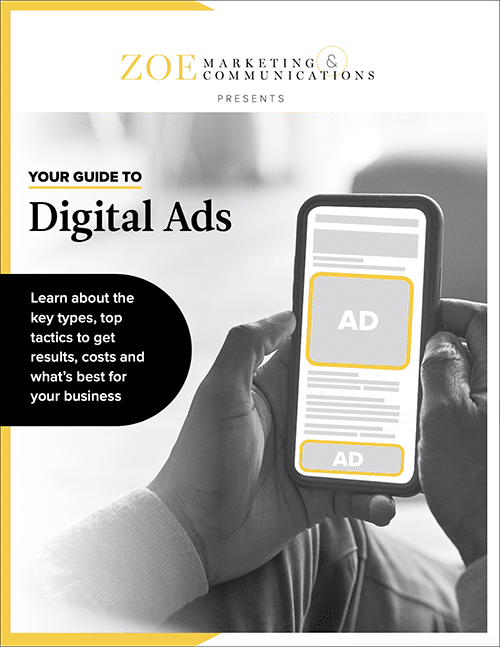
Download Your Digital Ads Guide
Learn how digital ads can help your business, including the tools, techniques and strategies to create successful campaigns.
Topics:

Programmatic advertising is big — so big that marketers devote around 54% of their budgets to it, according to Statista. But is it the right investment for your business?
You may have heard that programmatic is highly effective but costlier than other digital ad options. That can make it a trickier choice.
At Zoe Marketing & Communications, we’ve helped businesses navigate digital marketing since 2020 and work with high-quality programmatic providers.
Read on to get more grounded in what programmatic is, what it can bring to your business — and your possible next steps.
Learn how digital ads can help your business, including the tools, techniques and strategies to create successful campaigns.
Programmatic refers to buying digital ads via an automated bidding system. Tech companies — called trade desks and demand-side platforms (DSPs) — secure ad space across websites, apps and more. Marketing agencies manage the process for businesses.
Buying and selling happen in real-time, with ads targeted based on browsing behaviors and interests. The goal? Get people to click, visit your landing page and take action.
Programmatic allows precise audience targeting, including:
For example, if you want to reach 20-40-year-old outdoor enthusiasts in Illinois, you can.
Even with growing opt-outs, cookies and third-party trackers still gather substantial data, helping pinpoint ideal audiences.
Programmatic ads run across various platforms, including:
Different tactics influence where your ad appears. Display ads offer the most targeting options, while retargeting serves ads to users who previously engaged with your content.
Unlike search engine marketing (SEM), which relies on keywords, programmatic uses behavioral data to serve ads proactively.
It also differs from social media ads, which only target users on a specific platform.
The best approach? A blend of marketing tactics, tailored to your goals.
Consistency is key. Aim for at least three months — one to let the algorithm learn and two more to optimize.
Tweaks may be needed along the way, such as adjusting creative or targeting.
Programmatic works for businesses at all stages. It’s especially useful for branding and reaching people who may not yet be searching for your product.
Because it’s behavior-based, it keeps you in a buyer’s line of vision before they even realize they need you.
You can’t buy programmatic ads directly — only through a marketing agency. Think of it like buying a car. You don’t go to the manufacturer; you work with a dealer.
An agency ensures your ads run on high-quality sites, tracks performance and refines campaigns.
Costs vary based on ad quality, platform and targeting. Generally, expect a cost per thousand impressions (CPM) of $1-$15. Agencies may also require minimum ad spends.
Programmatic advertising is powerful, but it requires expertise. You’ve learned how it works, where ads appear, and why working with an agency is essential.
If you’re ready to explore programmatic, talk to us at Zoe Marketing & Communications. We’ll guide you through your options.
Still researching? Learn more about other ad types:

Learn how digital ads can help your business, including the tools, techniques and strategies to create successful campaigns.
As Zoe Marketing & Communications’ content manager, Kim Kovelle brings over 20 years of writing and editing experience in metro Detroit. She has strong roots in community journalism and a knack for making complicated topics make more sense.
Topics:
